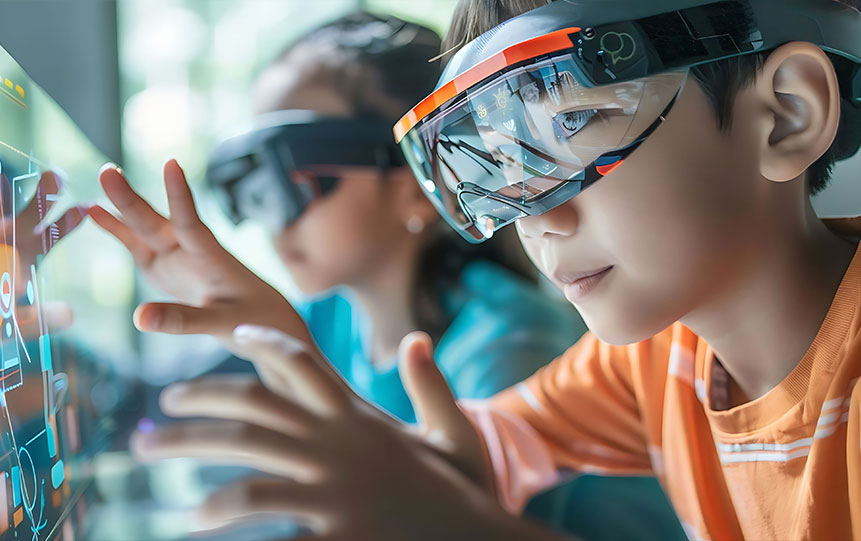Jul 15 2024
Transforming STEM Learning with AR and VR Technologies

VP Learning Solutions

Jul 15 2024

VP Learning Solutions

STEM education focuses on the integration of Science, Technology, Engineering, and Mathematics into a cohesive learning paradigm based on real-world applications. STEM education aims to foster critical thinking, creativity, and problem-solving skills among students, preparing them for careers in a rapidly evolving technological landscape.
Despite its importance, the current state of STEM education in the United States reveals significant challenges that necessitate change. Hence, a large proportion of students still find STEM subjects difficult to engage with and understand.
According to the National Assessment of Educational Progress (NAEP), only 37% of high school seniors are proficient in math, and just 25% in science. The disconnect often stems from traditional teaching methods that struggle to make abstract concepts tangible and engaging for students.
This blog discusses some of the key challenges in STEM education and how using transformative AR/VR solutions in STEM education can greatly enhance engagement and experiential learning.
The key challenges in STEM education include:
This is where Augmented Reality (AR) and Virtual Reality (VR) enter the picture by offering innovative solutions to these challenges. AR superimposes digital information such as images, videos, and sounds, onto the real world via devices like smartphones and AR glasses. For example, AR apps like Google Expeditions allow students to take virtual field trips to historical sites, underwater worlds, or even inside the human body.
VR, on the other hand, immerses users in a completely digital environment, often using headsets and controllers to create a sense of presence in a virtual world. For example, VR apps or platforms can provide virtual labs where students can conduct experiments in a risk-free environment and offer immersive learning experiences across various subjects.
AR and VR technologies can revolutionize STEM education by addressing current challenges, thus creating new opportunities for engagement and learning.
One of the most significant benefits of AR and VR in education is their ability to enhance student engagement. Traditional lecture-based teaching methods often fail to capture the interest of students, leading to disengagement and a lack of motivation. AR and VR technologies, however, create immersive and interactive experiences that can make learning more exciting and engaging.
Many STEM concepts are abstract and difficult to visualize. Yet AR and VR technologies can help students better understand these concepts by providing visual and interactive representations.
AR and VR offer experiential learning opportunities that traditional methods cannot. These technologies can simulate real-world environments and scenarios, allowing students to learn through experience and practice.
AR and VR can facilitate collaborative learning and problem-solving. These technologies allow students to work together in virtual spaces, regardless of their physical locations, fostering teamwork and communication skills.
The potential of AR and VR in STEM education is undeniable. However, implementing these technologies effectively requires careful consideration of some key challenges. In the following, we discuss the potential challenges for which MRCC EdTech provides comprehensive AI-powered AR/VR content creation solutions to empower educators and ignite student passion for STEM:
Challenge 1:
Cost: The initial investment in AR/VR hardware can be significant, especially for schools with limited budgets. This can create an accessibility barrier for some institutions.
Our Solution:
Cost-Effective Content Creation: MRCC EdTech’s AI-powered platform can streamline the development process, thus reducing production costs and making high-quality AR/VR content more accessible.
Challenge 2:
Content Availability and Relevance: While AR/VR content is growing, there’s still a shortage of high-quality, curriculum-aligned experiences specifically designed for STEM education. Ensuring that the available AR/VR content is relevant and up to date with current STEM curricula presents another challenge. Outdated or poorly designed content can hinder learning rather than enhance it.
Our Solution:
Curriculum-Aligned and Immersive Learning Experiences: At MRCC EdTech, we address these challenges by working closely with educators and subject matter experts to develop engaging and interactive AR/VR experiences that directly align with specific learning objectives and curriculum standards. Leveraging the power of AI (Artificial Intelligence), we create simulations that enable students to visualize abstract concepts, making them more intuitive. For example, molecular structures, mathematical functions, and geological formations become easier to understand as students can interact with 3D models and observe dynamic processes in a virtual environment. This interaction and visualization process helps students gain deeper insights into scientific principles. By fostering curiosity, promoting active participation, and deepening understanding, our AR/VR experiences ensure that the content is high-quality, relevant, and up to date with the latest STEM curricula.
Challenge 3:
Technical Expertise: Integrating AR/VR effectively into STEM education requires an understanding of the technology and its pedagogical implications specifically within this domain. Not all educators will feel comfortable with lesson planning and implementing these new tools in their STEM classrooms.
Our Solution:
Professional Development and Support: MRCC EdTech provides educators with the necessary content support to feel confident integrating AR/VR technologies into their classrooms.
Challenge 4:
Student Access and Equity: Unequal access to devices can exacerbate existing educational inequalities. Ensuring equitable access to AR/VR experiences is crucial for inclusive learning.
Our Solution:
Accessible and Inclusive Design Approach: Accessibility is a core principle in our content development. Thus, we ensure that our AR/VR experiences are designed for diverse learners, considering factors like physical limitations, learning styles, and potential for motion sickness.
At MRCC EdTech, we understand the complexities of integrating new technologies into the classroom. Our AI-powered AR/VR content solutions are designed to be accessible, high-quality, and aligned with educational standards, thereby ensuring a seamless and impactful implementation. Contact us today to learn how we can support your institution in overcoming these challenges and revolutionizing STEM education.
Leave A Reply
Your email address will not be published. Required fields are marked *